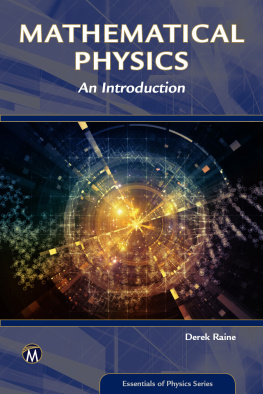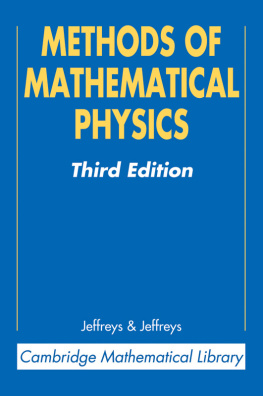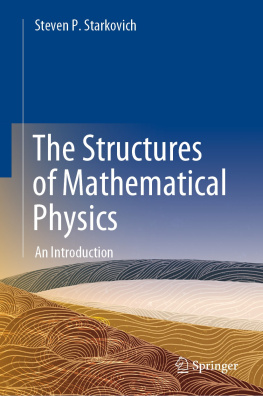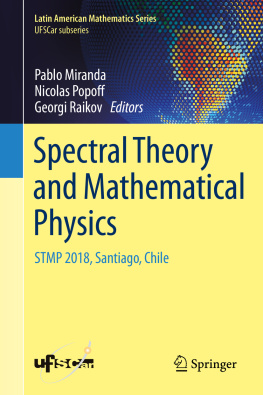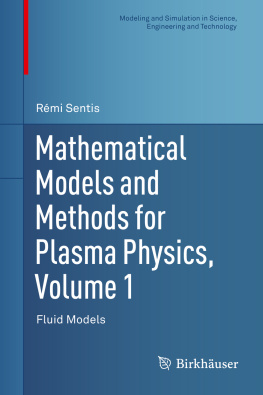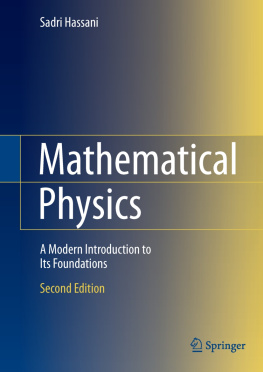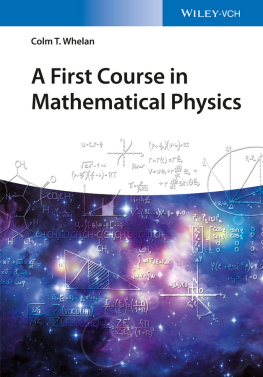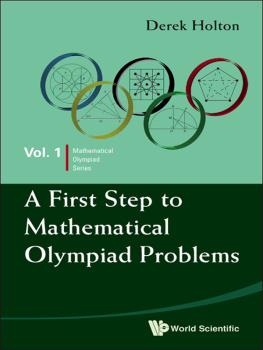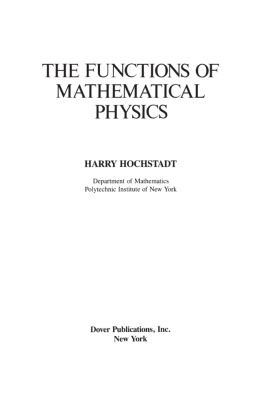Derek Raine - Mathematical Physics
Here you can read online Derek Raine - Mathematical Physics full text of the book (entire story) in english for free. Download pdf and epub, get meaning, cover and reviews about this ebook. year: 2018, publisher: Mercury Learning and Information, genre: Children. Description of the work, (preface) as well as reviews are available. Best literature library LitArk.com created for fans of good reading and offers a wide selection of genres:
Romance novel
Science fiction
Adventure
Detective
Science
History
Home and family
Prose
Art
Politics
Computer
Non-fiction
Religion
Business
Children
Humor
Choose a favorite category and find really read worthwhile books. Enjoy immersion in the world of imagination, feel the emotions of the characters or learn something new for yourself, make an fascinating discovery.
- Book:Mathematical Physics
- Author:
- Publisher:Mercury Learning and Information
- Genre:
- Year:2018
- Rating:3 / 5
- Favourites:Add to favourites
- Your mark:
- 60
- 1
- 2
- 3
- 4
- 5
Mathematical Physics: summary, description and annotation
We offer to read an annotation, description, summary or preface (depends on what the author of the book "Mathematical Physics" wrote himself). If you haven't found the necessary information about the book — write in the comments, we will try to find it.
Mathematical Physics — read online for free the complete book (whole text) full work
Below is the text of the book, divided by pages. System saving the place of the last page read, allows you to conveniently read the book "Mathematical Physics" online for free, without having to search again every time where you left off. Put a bookmark, and you can go to the page where you finished reading at any time.
Font size:
Interval:
Bookmark:

PHYSICS
LICENSE, DISCLAIMER OF LIABILITY, AND LIMITED WARRANTY
By purchasing or using this book (the Work), you agree that this license grants permission to use the contents contained herein, but does not give you the right of ownership to any of the textual content in the book or ownership to any of the information or products contained in it. This license does not permit uploading of the Work onto the Internet or on a network (of any kind) without the written consent of the Publisher. Duplication or dissemination of any text, code, simulations, images, etc. contained herein is limited to and subject to licensing terms for the respective products, and permission must be obtained from the Publisher or the owner of the content, etc., in order to reproduce or network any portion of the textual material (in any media) that is contained in the Work.
MERCURY LEARNING AND INFORMATION (MLI or the Publisher) and anyone involved in the creation, writing, or production of the companion disc, accompanying algorithms, code, or computer programs (the software), and any accompanying Web site or software of the Work, cannot and do not warrant the performance or results that might be obtained by using the contents of the Work. The author, developers, and the Publisher have used their best efforts to insure the accuracy and functionality of the textual material and/or programs contained in this package; we, however, make no warranty of any kind, express or implied, regarding the performance of these contents or programs. The Work is sold as is without warranty (except for defective materials used in manufacturing the book or due to faulty workmanship).
The author, developers, and the publisher of any accompanying content, and anyone involved in the composition, production, and manufacturing of this work will not be liable for damages of any kind arising out of the use of (or the inability to use) the algorithms, source code, computer programs, or textual material contained in this publication. This includes, but is not limited to, loss of revenue or profit, or other incidental, physical, or consequential damages arising out of the use of this Work.
The sole remedy in the event of a claim of any kind is expressly limited to replacement of the book, and only at the discretion of the Publisher. The use of implied warranty and certain exclusions vary from state to state, and might not apply to the purchaser of this product.
PHYSICS
An Introduction
Derek Raine, PhD et al.

MERCURY LEARNING AND INFORMATION
Dulles, Virginia
Boston, Massachusetts
New Delhi
Copyright 2019 by MERCURY LEARNING AND INFORMATION LLC. All rights reserved.
Original title and copyright: Mathematical Methods for Physical Science by Derek Raine et al. Copyright 2018 Pantaneto Press. All rights reserved.
This publication, portions of it, or any accompanying software may not bereproduced in any way, stored in a retrieval system of any type, or transmittedby any means, media, electronic display or mechanical display, including, but notlimited to, photocopy, recording, Internet postings, or scanning, without priorpermission in writing from the publisher.
Publisher: David Pallai
MERCURY LEARNING AND INFORMATION
22841 Quicksilver Drive
Dulles, VA 20166
www.merclearning.com
1-(800)-232-0223
D. Raine et al. Mathematical Physics.
ISBN: 9781683922056
The publisher recognizes and respects all marks used by companies, manufacturers, and developers as a means to distinguish their products. All brand names andproduct names mentioned in this book are trademarks or service marks of theirrespective companies. Any omission or misuse (of any kind) of service marks ortrademarks, etc. is not an attempt to infringe on the property of others.
Library of Congress Control Number: 2018949983
181920321 This book is printed on acid-free paper in the United States of America.
Our titles are available for adoption, license, or bulk purchase by institutions, corporations, etc. For additional information, please contact the Customer
Service Dept. at (800) 232-0223 (toll free).
All of our titles are available in digital format at authorcloudware.com and otherdigital vendors. The sole obligation of MERCURY LEARNING AND INFORMATION tothe purchaser is to replace the book, based on defective materials or faultyworkmanship, but not based on the operation or functionality of the product.
10.1Functions of two variables
Functions of two variables
The book differs from other introductions to mathematical methods at this level in several important regards.
First, it does not follow the usual presentation of a description of the theory followed by examples and exercises. Rather we use examples to introduce the theory. This approach is not new; it goes back to the methods by which the scribes of Ancient Babylon learned mathematics: by example problems and, to judge from the numbers of surviving cuneiform tablets, lots of them!
Second, to help the reader digest the text, it is broken up into quite short sections (often a page or so) followed by exercises. It may be tempting to skip the exercises (especially if one is used to doing only a selection of end-of-chapter problems), on the grounds that one can get through the book more quickly that way. This is true, in the same sense that watching a film speeded up 8 will get to the end more quickly, but it will be without much understanding of the plot. There are optional additional exercises at the end of each chapter; the ones in the text represent the minimum we think you need.
Third, however, we have tried to avoid too many plug-and-chugexercises, that is, exercises which you solve by following the text but substituting some different numbers (pattern matching). These are useful to reinforce memory, but they are not very useful to develop or test understanding. Rather, we have tried to make the exercises diagnostic in the sense that they do test understanding, that is, they test the ability to use what has been learned in a slightly different context.An instructor can therefore use these to target support for students.
Finally, and related to the previous point, while we hope it is perfectly possible to use this book for self-study, it was not designed for that purpose. It is intended for use as a course text. In this regard it might be useful to say a little about the background to the writing of the book - especially if you are intrigued to know why there are so many authors. We would also like to thank contributions to various versions of the text from Paul Abel, Mike Dampier, Andrew King and Tim Yeoman.
About forty years ago, it was agreed that our conventional presentation of mathematical methods for our physics students - lectures, marked homework and examinations - was not as effective at we might have hoped. So, instead of spending lecture time going through theory and exercises on the board, we produced a text as, in effect, the lecture notes, and refocused class time on weekly workshops and small group tutorials. Lectures were restricted to a weekly one-hour introduction to the topics for that week. We made the examinations harder, by requiring passes separately in the major topics (calculus of one variable, many variables, linear algebra, differential equations, vector calculus) and the pass rates soared. The initial text has been refined over the years (hence the number of authors) and this book is another, more outward-facing, version, which we are pleased to have the opportunity to share with you.
Font size:
Interval:
Bookmark:
Similar books «Mathematical Physics»
Look at similar books to Mathematical Physics. We have selected literature similar in name and meaning in the hope of providing readers with more options to find new, interesting, not yet read works.
Discussion, reviews of the book Mathematical Physics and just readers' own opinions. Leave your comments, write what you think about the work, its meaning or the main characters. Specify what exactly you liked and what you didn't like, and why you think so.

